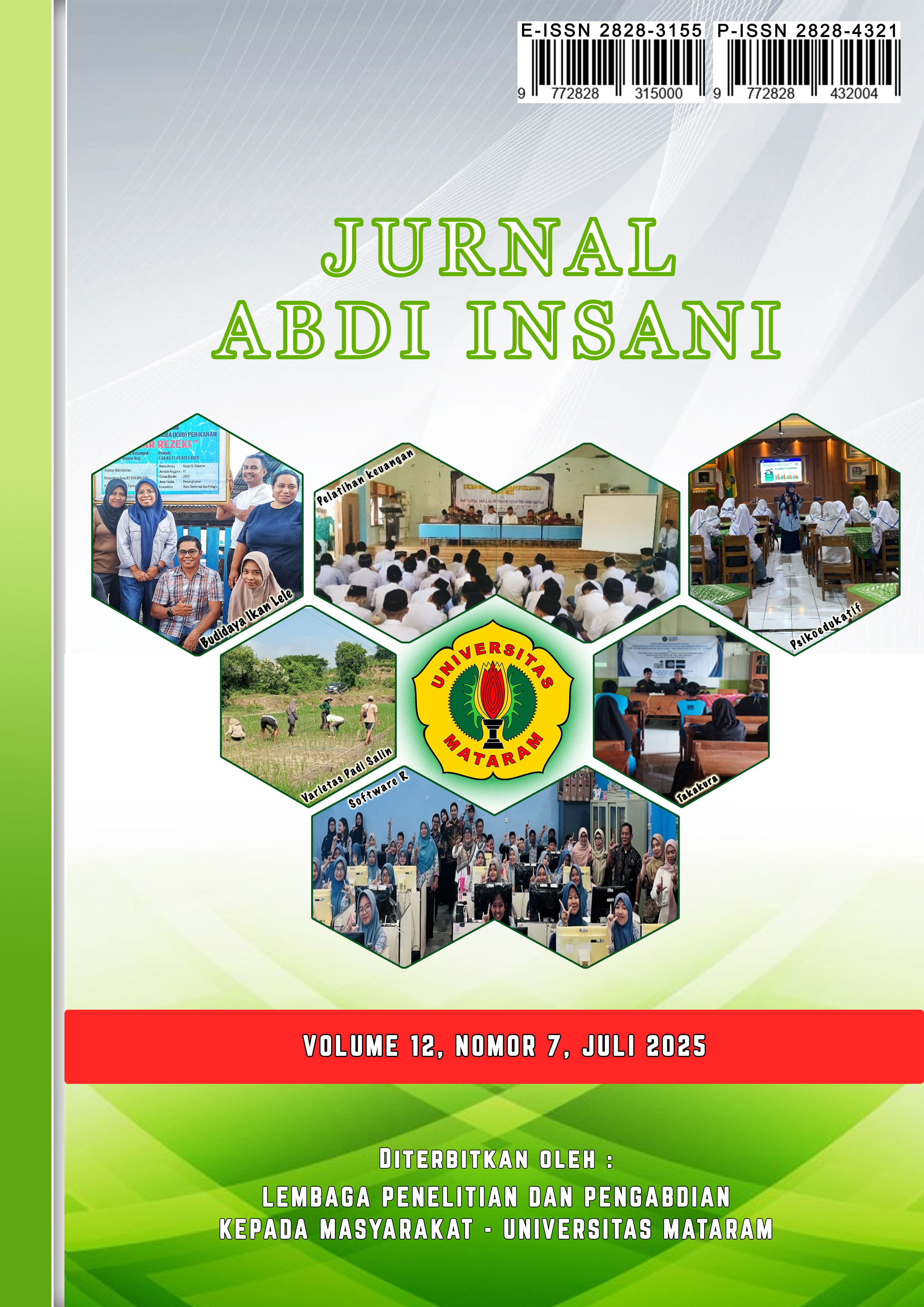OPTIMALISASI KESELAMATAN KERJA PERAWAT MELALUI PENINGKATAN KEPATUHAN TERHADAP PENGELOLAAN LIMBAH MEDIS PADAT
DOI:
https://doi.org/10.29303/abdiinsani.v12i7.2586Keywords:
Nurse, Sharp Objects, Solid Medical Waste, Waste Sorting, Waste ManagementAbstract
Improper management of solid medical waste in hospitals has a high risk of causing the spread of occupational diseases and accidents in nurses. One of the occupational accidents that often occurs was being pricked by a needle or scratched by a sharp object, both while working and when disposing of waste. The purpose of this activity was to observe and assess nurses' compliance in managing solid medical waste. This community service was carried out in inpatient room A in a hospitals. There were two activities in this community service. First, compiling a measurement tool for compliance with solid medical waste management. Second, socialization related to the compliance measurement tool, the results of the assessment of nurses' compliance in waste management, the importance of compliance in managing solid medical waste, waste sorting and management procedures. The results of this activity were the availability of two observation sheets, namely: an observation sheet for compliance with the disposal of infectious, non-infectious and cytotoxic waste and an observation sheet for compliance with sharp waste management. The results of the trial of the compliance measurement tool showed that nurses' compliance in managing solid medical waste was still not optimal. The conclusion of this activity shows that compliance with solid medical waste management procedures or nurses' self-awareness towards the importance of maintaining occupational safety and health was not optimal.
Downloads
References
Arum, D. P. P., Erwin, & Amir, Y. (2022). Gambaran Pengelolaan Limbah Infeksius oleh Perawat di
Ruang Rawat Inap RSUD Provinsi Riau. Jurnal Medika Hutama, 03(02), 2375–2385.
Come, R. M., Sarungallo, Z. L., & Lisangan, M. M. (2022). Karakteristik limbah medis padat dan
pengelolaannya di Rumah Sakit Umum Daerah Manokwari. Cassowary, 5(1), 22–34.
https://doi.org/10.30862/casssowary.cs.v5.i1.95
Efendi, N. H., Rato, D., & Soetijono, I. R. (2023). Prinsip Kehati-Hatian dalam Pengelolaan Limbah Medis
untuk Mewujudkan Kehidupan yang Berkelanjutan. DiH: Jurnal Ilmu Hukum, 19(2), 146–155.
Heriwati, Meliyanti, F., & Budianto, Y. (2023). Pengelolaan Limbah Medis di Rumah Sakit berdasarkan
Pengetahuan dan Sikap Perawat. Jurnal Ilmiah Multi Science Kesehatan, 15(2), 216–224.
https://doi.org/10.36729/bi.v15i2.1146
Kemenkes RI. (2019). Peraturan Menteri Kesehatan Republik Indonesia Nomor 7 Tahun 2019 tentang
Kesehatan Lingkungan Rumah Sakit.
Kemenkes RI. (2020). Peraturan Menteri Kesehatan Republik Indonesia Nomor 18 Tahun 2020 tentang
Pengelolaan Limbah Medis Fasilitas Pelayanan Kesehatan Berbasis Wilayah.
KLHK. (2015). Peraturan Menteri Lingkungan Hidup dan Kehutanan Republik Indonesia Nomor :
P.56/Menlhk-Setjen/2015 tentang Tata Cara dan Persyaratan Teknis Pengelolaan Limbah Bahan
Berbahaya dan Beracun dari Fasilitas Pelayanan Kesehatan.
Ningrum, S. S., & Tualeka, A. R. (2021). Upaya Pengendalian Risiko pada Unit Pengelolaan Limbah
Medis Benda Tajam di Rumah Sakit. Journal of Public Health Education, 1(1), 40–47.
https://journals.prosciences.net/index.php/JPHE/article/download/16/10
Pradnyana, I. G. N. G., & Mahayana, I. M. B. (2020). Hubungan pengetahuan dan sikap dengan perilaku
perawat dalam pengelolaan sampah medis di rumah sakit daerah mangusada kabupaten badung.
Jurnal Kesehatan Lingkungan, 10(2), 72–78. https://doi.org/10.33992/jkl.v10i2.1271
Priyatno, A. D. (2022). Analisis Sistem Pengolahan Limbah Padat Medis di Puskemas Sako Kota
Open access article under the CC–BY-SA license. Copy right © 2024, Yulis et al., 3105
Palembang Tahun 2022. Indonesian Journal of Health and Medical, 2(4), 387–401.
Rochmawati, E. S., & Has, D. F. S. (2023). Analisis Pengelolaan Limbah Medis Padat Di Rumah Sakit
Medika Mulia Tuban. Journal of Public Health Science Research, 3(2), 23.
https://doi.org/10.30587/jphsr.v3i2.5622
Wati, N. M., Rupiwardani, I., & Wahyuni, I. D. (2024). Kepatuhan Perawat dalam Pemilahan Limbah
Medis dan Non Medis di Ruang Rawat Inap Rumah Sakit Islam ‘Aisyiyah Nganjuk. Jurnal Kesehatan
Tambusai, 5(4), 10290–10300. https://doi.org/10.31004/jkt.v5i4.34517
Wijaya, H., Alwi, M. K., & Baharuddin, A. (2021). Analisis Risiko Keselamatan dan Kesehatan Kerja (K3)
Dalam Pengelolaan Limbah Medis Rumah Sakit Islam Hasanah Muhammadiyah Mojokerto Di
Masa Pandemi COVID-19. Journal of Muslim Community Health (JMCH), 2(1), 36–51.
https://doi.org/10.52103/jmch.v2i1.487
Yulis, R. (2020). Pengalaman kepala ruangan mengidentifikasi penyakit dan kecelakaan akibat kerja :
Studi qualitatif (Experience of head nurse in identifying occupational disease and accidents : a
qualitative study). Jurnal Ilmiah Perawat Manado, 08(01), 108–126.
https://doi.org/10.47718/jpd.v8i01.1011
Yulis, R., Fitri, G., & Fitriani. (2025). Phenomenology Study : Occupational Diseases and Accidents in
Nurses in Coastal and Border Areas. 18(1), 86–96. https://doi.org/10.23917/bik.v18i1.6840




















